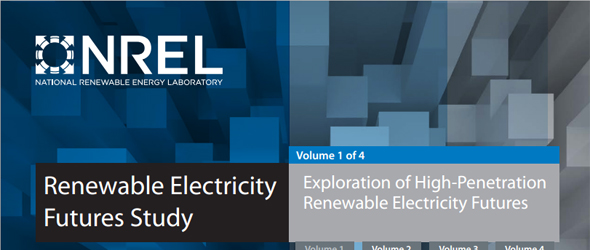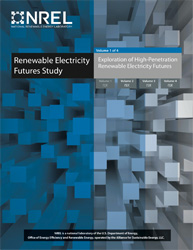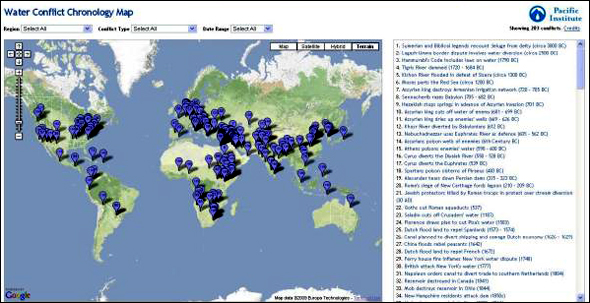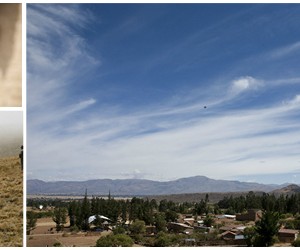Study: 80 Percent of U.S. Electricity from Renewables Is Technically Feasible, But Faces Significant Barriers
A massive U.S. government study shows what an electrical grid powered largely by renewable sources looks like, but not the path to get there.
By Brett Walton
Circle of Blue
Renewable energy technologies that are commercially available today — combined with a more flexible electrical grid — are “more than adequate” to supply 80 percent of the nation’s projected electricity demand in 2050, according to a new study by National Renewable Energy Laboratory, a federal U.S. energy laboratory.
However, NREL is careful to point out that the study is solely a technical assessment, and it does not address the state and federal policies needed to usher in such a system. The changes to the electrical grid alone would require a substantial mechanical and operational makeover.
Yet, in what it calls the most detailed study of its kind to date, the NREL says the benefits of such a system would extend to the waters and the skies, noting that there are “multiple combinations” of renewable technologies that would lead to “deep reductions” in water use and in greenhouse gas emissions.
For instance, fears about intermittent power have plagued the discussion for some renewables, namely wind and solar, for decades. But these fears are unfounded, based on the new Renewable Electricity Futures Study, in which wind and solar contributed half of the renewable electricity generation in the main computer-modeling scenario that was used. Moreover, the report says, not only would intermittent power not be a problem, but the summation of all renewable technologies — biomass, geothermal, hydropower, solar, and wind — could meet hour-by-hour demand in all regions of the country.
“If we’re talking about a low-carbon future,” said George Douglas, a spokesman for NREL, in an interview with Circle of Blue, “then we need to answer, ‘What is possible? What do the technology and resources allow?’ And the study points out that this is all possible.”
Policies and Possibilities
Possible, yes. But also exceedingly difficult. The report’s authors write in the executive summary to the four-volume, 854-page study that “a transformation of the electricity system would need to occur to make this future a reality.”
“This transformation,” they write, “involving every element of the grid, from system planning through operation, would need to ensure adequate planning and operating reserves, increased flexibility of the electric system, and expanded multi-state transmission infrastructure, and would likely rely on the development and adoption of technology advances, new operating procedures, evolved business models, and new market rules.”
— Marchant Wentworth
Union of Concerned Scientists
In other words, the energy overhaul would require a loosely coordinated group of utilities, energy companies, and oversight agencies that would span the nation to radically refashion one of the most fundamental technological pillars of modern American society — and the policy and economic hurdles are no less daunting.
“This is a political question,” said Marchant Wentworth, the deputy legislative director for the climate and energy program of the Union of Concerned Scientists, about the possibility of a future grid fed from renewable sources. “This is not a ‘Can we get there?’ question.”
As the study makes clear, shifting to renewable sources of electricity requires changes in how electricity is generated, stored, and transmitted, as well as how the grid is operated.
“The report is valuable for the current political climate, to show that renewables can, in fact, do the job,” Wentworth told Circle of Blue. “It shows what the destination looks like, but doesn’t answer how to get there.”
Benefits and Opposition
The water benefits of such a journey would be immense. In 2005, according to the U.S. Geological Survey, the thermoelectric power sector made up 41 percent of all freshwater withdrawals. This water — most of which is returned to water bodies — is used to cool the steam that turns turbines. Wind farms and solar photovoltaic arrays, by contrast, require almost no water to generate electricity.
The energy transformation is being buffeted, not only by disagreement in Congress over carbon emissions and government financial support for renewable energy, but also, in many cases, by local opposition to utility-scale wind and solar projects and to new high-voltage transmission lines.
— George Douglas
National Renewable Energy Laboratory
For example, Duke Energy recently scrapped plans for a wind farm in northern Michigan, as did Buckeye Wind Energy in Ohio. Additionally, many residents of Colorado’s San Luis Valley, the nation’s highest agricultural region, question the federal government’s plan to designate some 6,500 hectares (16,000 acres) of public land in their sunny valley for solar energy development. Meanwhile, solar development in California’s Mojave Desert has been beset by lawsuits over endangered species, as well as concerns about aquifer depletion and the effects on fragile ecosystems.
Adding to the challenge is the nation’s fossil-fuel revival. Invigorated by a combination of horizontal drilling and hydraulic fracturing, a drilling boom has swept through the country’s mid-section, from North Dakota to Ohio, lowering natural gas prices, enriching landowners, and prompting energy companies to switch from coal to gas.
Furthermore, the natural gas conversion has come with a strong carbon-emissions dividend. According to the International Energy Agency, carbon dioxide emissions in the U.S. have fallen by 7.7 percent since 2006, the steepest reduction of any country. The EIA estimates that U.S. carbon emissions may drop to 1990 levels by the end of the year.
Because of this, the Energy Information Administration (EIA), the federal government’s energy research agency, expects renewable sources of electricity to comprise just 15 percent of the nation’s electricity mix by 2035, up from 10 percent today.
Successes and Connections
Still, many states have put in place renewable energy targets — though many in the West are close to being met — and a few of the big new transmission- and grid-integration projects, like Tres Amigas in eastern New Mexico, are in the permitting process. For now, Tres Amigas will be the only interconnection between the country’s three electrical grids, which are currently segregated.
David Stidham, senior vice president and chief operating officer for Tres Amigas, told Circle of Blue that the company is finalizing its contractors and signing power agreements. The first phase, expected to be ready in March 2015, will yield a 750-megawatt connection between the grids serving the eastern U.S. and western U.S; the 1,500-megawatt second phase will connect Texas, which is on an electrical island, to the eastern grid.
With the new report, the technical parameters have been established, said NREL spokesman Douglas, so now “the conversation is, ‘Is this what we want to do?’”
Brett writes about agriculture, energy, infrastructure, and the politics and economics of water in the United States. He also writes the Federal Water Tap, Circle of Blue’s weekly digest of U.S. government water news. He is the winner of two Society of Environmental Journalists reporting awards, one of the top honors in American environmental journalism: first place for explanatory reporting for a series on septic system pollution in the United States(2016) and third place for beat reporting in a small market (2014). He received the Sierra Club’s Distinguished Service Award in 2018. Brett lives in Seattle, where he hikes the mountains and bakes pies. Contact Brett Walton










Sounds like the next analytical step is to begin the process of “backcasting,” a la The Natural Step.
Think of the water and energy savings (and job creation) that we would realize if we sidelined a fundamental transformation of our energy grid and started focusing on a real problem that has been screaming for funding – the repair/replacement of our water infrastructure. Sounds to me like we have our priorities backwards, and, in an economy such as ours, this is not something we can afford to mess around with.